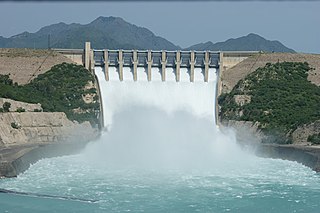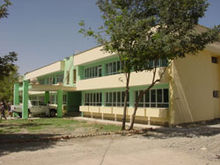
Balochistan is one of the four provinces of Pakistan. It is the largest province in terms of land area, forming the southwestern region of the country, but is the least populated. Its provincial capital and largest city is Quetta.

Pakistan, officially the Islamic Republic of Pakistan, is a country in South Asia. It is the world’s sixth-most populous country with a population exceeding 212.7 million people. In area, it is the 33rd-largest country, spanning 881,913 square kilometres. Pakistan has a 1,046-kilometre (650-mile) coastline along the Arabian Sea and Gulf of Oman in the south and is bordered by India to the east, Afghanistan to the west, Iran to the southwest, and China in the northeast. It is separated narrowly from Tajikistan by Afghanistan's Wakhan Corridor in the northwest, and also shares a maritime border with Oman.

The Taliban or Taleban, who refer to themselves as the Islamic Emirate of Afghanistan (IEA), are a Sunni Islamic fundamentalist political movement and military organization in Afghanistan currently waging war within that country. Since 2016, the Taliban's leader is Mawlawi Hibatullah Akhundzada.

Hamid Karzai is an Afghan politician who was the President of Afghanistan from 22 December 2001 to 29 September 2014, originally as an interim leader and then as President for almost ten years, from 7 December 2004 to 2014. He comes from a politically active family; Karzai's father, uncle and grandfather were all active in Afghan politics and government. Karzai and his father before him, Abdul Ahad Karzai, were each head of the Popalzai tribe of the Durrani tribal confederation.

Tarbela Dam is an earth-filled dam on the Indus River in Khyber Pakhtunkhwa, Pakistan. Located in the Swabi and Haripur Districts of Khyber Pakhtunkhwa, the dam is about 30 km (20 mi) from the city of Swabi, 105 km (65 mi) northwest of Islamabad, and 125 km (80 mi) east of Peshawar. The dam was completed in 1976 and was designed to store water from the Indus River for irrigation, flood control, and the generation of hydroelectric power.
The Iran–Pakistan gas pipeline, also known as the Peace pipeline, or IP Gas, is an under-construction 2,775-kilometre (1,724 mi) pipeline to deliver natural gas from Iran to Pakistan.

The Alternative Energy Development Board or AEDB, is the sole representing agency of the Federal Government that was established in May 2003 with the main objective to facilitate, promote and encourage development of Renewable Energy in Pakistan and with a mission to introduce Alternative and Renewable Energies (AREs) at an accelerated rate. The administrative control of AEDB was transferred to Ministry of Water and Power in 2006.

The Kajaki Dam is one of the two major hydroelectric power dams of Helmand province in southern Afghanistan. The dam is located on the Helmand River 100 miles (161 km) north-west of Kandahar and is operated by the Helmand and Arghandab Valley Authority. It has a dual function, to provide electricity and to irrigate some 650,000 acres (1800 km²) of an otherwise arid land. Water discharging from the dam traverses some 300 miles (500 km) of downstream irrigation canals feeding farmland. As of October 2016 it produces 52.5 megawatts of electricity.

As of 2017, nuclear power in Pakistan is provided by 5 commercial nuclear power plants. Pakistan is the first Muslim country in the world to construct and operate civil nuclear power plants. The Pakistan Atomic Energy Commission (PAEC), the scientific and nuclear governmental agency, is solely responsible for operating these power plants. As of 2012, the electricity generated by commercial nuclear power plants constitutes roughly ~3.6% of electricity generated in Pakistan, compared to ~62% from fossil fuel, ~33% from hydroelectric power and ~0.3% from coal electricity. Pakistan is not a party to the Nuclear Non-Proliferation Treaty but is a member of the International Atomic Energy Agency. Pakistan plans on constructing 32 nuclear power plants by 2050.

Since 1949, a series of armed skirmishes and firefights have occurred along the Durand Line between the Afghan National Security Forces and the Pakistan Armed Forces. The latest hostilities, which are ongoing, began with the overthrow of the Taliban government.

The insurgency in Khyber Pakhtunkhwa, also known as the War in North-West Pakistan, is an armed conflict involving Pakistan, and armed militant groups such as the Tehrik-i-Taliban Pakistan (TTP), Jundallah, Lashkar-e-Islam (LeI), TNSM, al-Qaeda, and their Central Asian allies such as the ISIL–Khorasan (ISIL), Islamic Movement of Uzbekistan, East Turkistan Movement, Emirate of Caucasus, and elements of organized crime.

Raja Pervaiz Ashraf, is a businessman, farmer, and politician who served as 19th prime minister of Pakistan from 22 June 2012 until completing his designated term on 16 March 2013. He is a Member of the National Assembly of Pakistan from NA-58 (Rawalpindi-II). He currently resides in Sanghar House, Gujar Khan.

Afghanistan–Pakistan relations involve bilateral relations between Afghanistan and Pakistan. The two neighbouring countries share deep historical and cultural links, each has declared itself an Islamic republic and both have become members of the South Asian Association for Regional Cooperation. Relations between the two countries have been strained since 1947, when Pakistan gained independence and Afghanistan was the sole country to vote against Pakistan's admission into the UN. Afghanistan immediately armed separatist movements in the nascent Pakistan and made irredentist claims to large swathes of Pakistani territory—which prevented the emergence of normalised ties between the two countries. Further tensions have arisen with various issues related to the War in Afghanistan (1978–present), and with the millions of Afghan refugees who have sought shelter in Pakistan since the start of that war. Water rights, the growing relations of India and Afghanistan, Afghanistan's continued refusal to accept the Durand Line as an international border have further complicated ties.
Drinking water supply and sanitation in Pakistan is characterized by some achievements and many challenges. Despite high population growth the country has increased the share of the population with access to an improved water source from 85% in 1990 to 92% in 2010, although this does not necessarily mean that the water from these sources is safe to drink. The share with access to improved sanitation increased from 27% to 48% during the same period, according to the Joint Monitoring Program for Water Supply and Sanitation. There has also been considerable innovation at the grass-root level, in particular concerning sanitation. The Orangi Pilot Project in Karachi and community-led total sanitation in rural areas are two examples of such innovation.

Electricity in Pakistan is generated, transmitted, distributed, and retail supplied by two vertically integrated public sector utilities: Water and Power Development Authority (WAPDA) for all of Pakistan, and the Karachi Electric (K-Electric) for the city of Karachi and its surrounding areas. There are around 42 independent power producers (IPPs) that contribute significantly in electricity generation in Pakistan.

The Khyber Pass is a mountain pass in the northwest of Pakistan, on the border with Afghanistan. It connects the town of Landi Kotal to the Valley of Peshawar at Jamrud by traversing part of the Spin Ghar mountains. An integral part of the ancient Silk Road, it has long had substantial cultural, economic, and geopolitical significance for Eurasian trade. Throughout history, it has been an important trade route between Central Asia and the Indian subcontinent and a vital strategic military choke point for various states that came to control it. The summit of the pass is 5 km (3.1 mi) inside Pakistan at Landi Kotal, while the lowest point is at Jamrud in the Valley of Peshawar. The Khyber Pass is part of Asian Highway 1 (AH1).

The energy policy of Pakistan is formulated and determined by the federal, provincial, and local institutional entities in Pakistan, which address the issues of energy production, distribution, and consumption of energy, such as gas mileage and petroleum standards. Energy policy requires the proper legislation, international treaties, subsidies and incentives to investment, guidelines for energy conservation, taxation and other public policy techniques.

Renewable energy in Afghanistan includes biomass, hydropower, solar, and wind power. Afghanistan is a landlocked country surrounded by five other countries. With a population of less than 35 million people, it is one of the lowest energy consuming countries in relation to a global standing. It holds a spot as one of the countries with a smaller ecological footprint. Hydropower is currently the main source of renewable energy due to Afghanistan's geographical location. Its large mountainous environment facilitates the siting of hydroelectric dams and other facets of hydro energy.
China–Pakistan Economic Corridor is a collection of infrastructure projects that are currently under construction throughout Pakistan. Originally valued at $46 billion, the value of CPEC projects is worth $62 billion as of 2017. CPEC is intended to rapidly upgrade Pakistan's required infrastructure and strengthen its economy by the construction of modern transportation networks, numerous energy projects, and special economic zones. On 13 November 2016, CPEC became partly operational when Chinese cargo was transported overland to Gwadar Port for onward maritime shipment to Africa and West Asia, while some major power projects were commissioned by late 2017.



















